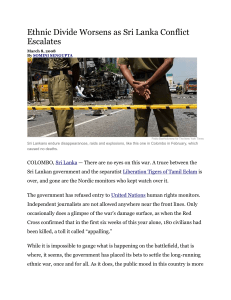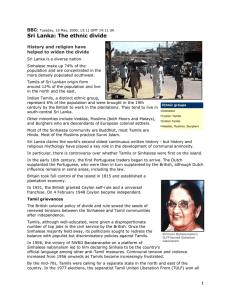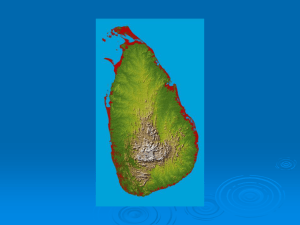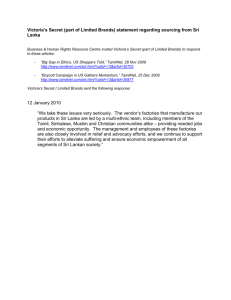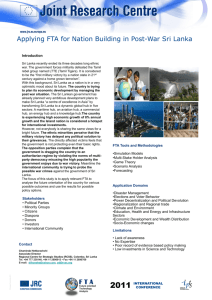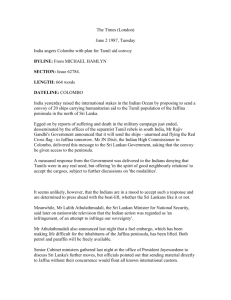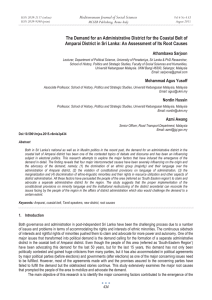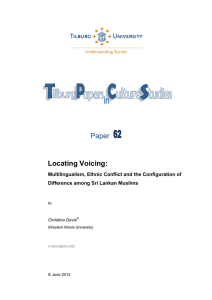Week 2: Sri Lanka - University of Warwick
advertisement
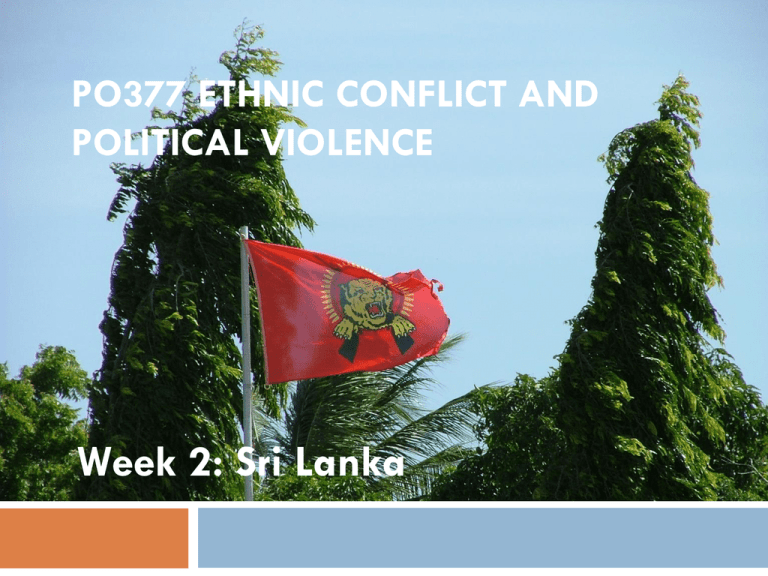
PO377 ETHNIC CONFLICT AND POLITICAL VIOLENCE Week 2: Sri Lanka Pop Quiz 1. 2. 3. 4. The conflict in Sri Lanka is between… Muslims and Hindus Muslims and Buddhists Tamils and Sinhalese Indian terrorists and the Sri Lankan state Lecture Outline Overview Pre-Colonial History Colonial Period Lead-up to independence Post-Independence History & Entrenchment of Nationalisms Competing historical narratives Competing analyses of conflict Sinhala state nationalism Tamil nationalism Civil War Conclusion Overview Population: estimated around 21 million (in 2012). Ethnic makeup (1980s estimate): roughly 74% Sinhalese, 13% Sri Lankan Tamil, 7.5% Muslim, 5% Indian Tamil, less than 1% other. Sinhalese: predominantly Buddhist, small Christian minority; Tamils: mostly Hindu, Christian minority. Civil war 1983-2009. Tamil nationalist groups fought the state for an independent Tamil state (Tamil Eelam) in the north and east. LTTE most powerful group. Possibly 90,000-110,000 people dead (20,000-40,000 in final months); 500,000+ have left Sri Lanka; up to 1,000,000 displaced at various points with many thousands still living in IDP camps. Channel 4 Documentary Do you find the documentary and its evidence credible? How does watching the documentary make you feel? What are some implications you could draw from it regarding the future of Sri Lanka? Pre-Colonial History Competing historical narratives Sinhalese narrative claims they were first ‘civilised’ settlers of Sri Lanka, from 5th/6th C. BC. Sinhalese history of SL based on Buddhist chronicle the Mahāvamsa and its myth of Prince Vijaya; Buddha entrusted the island to the Sinhalese people. Sinhala nationalism claims Tamils in north and east are descendants of Tamil-speaking Hindu ‘invaders’. Claims SL Tamils never had autonomous political units previously and accepted Sinhalese rule. Pre-Colonial History (2) Competing historical narratives Tamil narrative (less extreme) claims Tamils have lived in Sri Lanka for at least 1,000 years and have had autonomous political units. Tamil narrative (more extreme) claims Tamils settled first and Sinhalese were originally Tamils who later converted to Buddhism and adopted the Sinhala language. Pre-Colonial History (3) Competing analyses of conflict Primordial analyses of SL conflict: Sri Lanka has always been dominated by two exclusive and conflictual groups, Sinhala-speaking Buddhists and Tamil-speaking Hindus. Non-primordial analyses: groupings within Sri Lanka based on language and religion have been historically variable and intersecting social divisions. Before 19th C. was never a perfect congruence of ‘race’, language, religion and political territory. Current political identities have been generated by the form and formation of the modern SL state. Pre-Colonial History (4) ‘For long periods of time groups which would now be characterized in terms of the SinhalaTamil divide lived more or less at peace with one another. There were dynastic wars; but SinhalaTamil communal violence dates from after Independence. This is not to say that there were no differences between groups of people living in the island: the point is simply that differences of language, custom and religion were made into something new by the devices of a modern state.’ (Nissan and Stirrat, 1990) Colonial Period European ideas of ‘race’ that British rule brought were significant in development of nationalism. British policy influenced by new racial theories, incl. notion of ‘Aryanism’ (linguistic affinity = common ‘blood’). Buddhist revivalist movement from late 18th/early 19th century: resistance to old élite and to the British. Began as anti-imperialist but contributed to construction of SinhalaBuddhist nationalist identity. Circa 1890 on working-class called for economic improvements and union rights; emerging bourgeoisie demanded political reforms, equal opps and democratic rights from circa 1900. Colonial Period (2) Lead-up to independence 1) 1931 Constitution replaced communal representation with territorial electorates; with universal suffrage this led to Sinhalese majority rule. 2) 3) First general election 1931 (selfgovernment) – Sinhalese leadership unwilling to share power with minority ethnic groups. New administrative division of the island according to language. Post-Independence History & Entrenchment of Nationalisms Sinhala state nationalism 1) Citizenship Act 1948 and Indian and Pakistani Residents (Citizenship) Act 1949. 2) 3) 4) Language policies. Educational policy known as ‘standardisation’ from 1970. Official entrenchment of Buddhism and growth of political Buddhism. Post-Independence History & Entrenchment of Nationalisms (2) 5) 6) Economic alienation and exclusion from traditional employment for Tamils. Post-independence ‘ethnic outbidding’ very significant (see DeVotta, 2002). 7) ‘Colonisation schemes’ from 1950s. 8) 1979 Prevention of Terrorism Act. 9) Series of violent inter-communal (anti-Tamil) riots, beginning 1956 and culminating in 1983. Post-Independence History & Entrenchment of Nationalisms (3) Tamil nationalism 1. Federal Party from 1950s: stood for federal constitution with Northern and Eastern Provinces as states of a federal union. 2. 3. Non-violent protest campaigns met with repression; last one in 1964. Tamil push for secession from early 1970s; TULF formally demanded independent state in 1976. Post-Independence History & Entrenchment of Nationalisms (4) 4. 5. Small-scale Tamil guerrilla activity from early to mid-1970s; increased militancy from late 1970s. 1983: Tamil MPs forced out of Parliament by 6th amendment to Constitution requiring allegiance to unitary state; Amnesty Intl report on torture by armed forces and police; huge organised antiTamil riots in July. Civil War Split betw. Tamil parliamentarians (TULF) and militants from 1982; armed campaign increasingly significant. 1983: beginning of civil war, rush to join Tamil guerrilla groups. Mid-1980s: Liberation Tigers of Tamil Eelam (LTTE) aim to destroy competitors. Civil War (2) ‘Eelam War I’: July 1983 until 1987 Indo-Sri Lanka Peace Accord (or 1990 collapse of it). ‘Eelam War II’: 1990-95, brief ceasefire in 1995. ‘Eelam War III’: 1995 until start of ceasefire at the end of 2001/early 2002. ‘Eelam War IV’: Jan 2008 to May 2009. Conclusion European racial categories formed the framework for developing nationalist identities in Sri Lanka; after independence British were replaced by Tamils as the ‘threatening other’ for Sinhalese. Contemporary Sinhalese-Tamil conflict is partly result of processes begun by British colonialism: unification of country; introduction of unitary bureaucratic structure; import of western ideas of ‘race’ and its relation to ‘nation’; impact of mass media and state education; formalised communal political representation but then a shift to territorial representation. Conclusion (2) Contemporary conflict is also a result of postindependence political, social and economic changes that marginalised Tamils, along with intra-Sinhalese political competition (ethnic outbidding). Sri Lanka can be viewed as a ‘double minority’ model. Shift in Tamil demands from federal union to separate state and from non-violent to violent means: lesson in dangers of majority instituting ethnocentric unjust policies at expense of minority, BUT catch 22 problem here. Where to from here?? Pop Quiz 1. 2. 3. Sri Lanka will return to war… Within the next five years Within the next ten years Not within our lifetime


